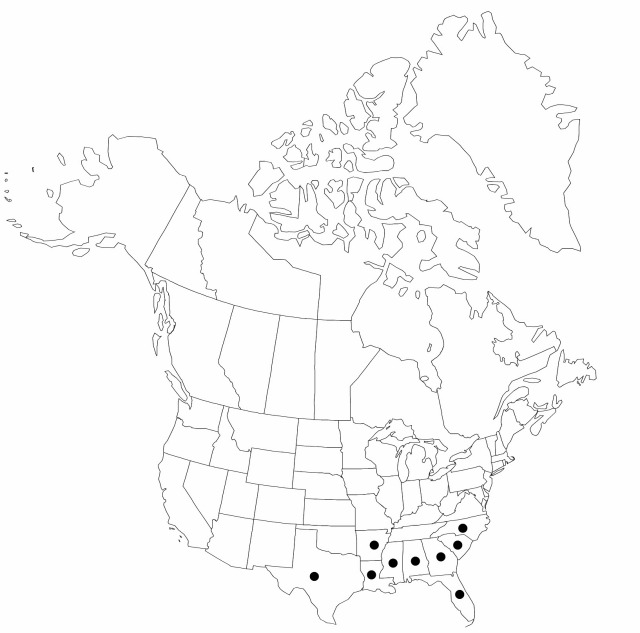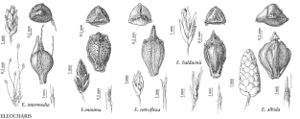Difference between revisions of "Eleocharis baldwinii"
Fl. South. U.S., 519. 1860.
FNA>Volume Importer |
imported>Volume Importer |
||
| Line 8: | Line 8: | ||
}} | }} | ||
|common_names=Baldwin’s spike-rush | |common_names=Baldwin’s spike-rush | ||
| + | |special_status={{Treatment/ID/Special_status | ||
| + | |code=W1 | ||
| + | |label= | ||
| + | }}{{Treatment/ID/Special_status | ||
| + | |code=F | ||
| + | |label=Illustrated | ||
| + | }}{{Treatment/ID/Special_status | ||
| + | |code=E | ||
| + | |label=Endemic | ||
| + | }} | ||
|basionyms={{Treatment/ID/Basionym | |basionyms={{Treatment/ID/Basionym | ||
|name=Chaetocyperus baldwinii | |name=Chaetocyperus baldwinii | ||
| Line 53: | Line 63: | ||
|publication title=Fl. South. U.S., | |publication title=Fl. South. U.S., | ||
|publication year=1860 | |publication year=1860 | ||
| − | |special status= | + | |special status=W1;Illustrated;Endemic |
| − | |source xml=https:// | + | |source xml=https://bibilujan@bitbucket.org/aafc-mbb/fna-data-curation.git/src/bb6b7e3a7de7d3b7888a1ad48c7fd8f5c722d8d6/coarse_grained_fna_xml/V23/V23_143.xml |
|genus=Eleocharis | |genus=Eleocharis | ||
|subgenus=Eleocharis subg. Eleocharis | |subgenus=Eleocharis subg. Eleocharis | ||
Revision as of 21:31, 27 May 2020
Plants annual(?), often mat-forming, often stoloniferous, sometimes entirely vegetative; rhizomes absent. Culms often arching, sometimes spotted or streaked red-brown, quadrangular or broadly elliptic, sulcate or not, 0.5–25(–30) cm × 0.1–0.4 mm, soft. Leaves: distal leaf sheaths persistent or disintegrating, stramineous, green, red-brown, or spotted or streaked red-brown, membranous, translucent, apex obtuse or acute. Spikelets: basal spikelets usually present, pistillate; often proliferous, ovoid, ellipsoid, or linear, clearly laterally compressed, 2.3–6.9 × 0.5–2 mm, apex acute, proximal scale empty, amplexicaulous, similar to floral scales (midribs sometimes more prominent and sometimes slightly prolonged beyond lamina); subproximal scale with a flower; floral scales clearly distichous, 3–9, 3–4 per mm of rachilla, yellowish, pale brown, or red-brown, spotted, streaked, or mottled red-brown, narrowly ovate to oblong, (1.5–)2–5 × 0.4–0.6(–1.2) mm, membranous, apex rounded, obtuse or rarely acute, midribs keeled. Flowers: perianth bristles 3–7, incurved, colorless, white, or red-brown, shorter than or equaling achene; spinules sparse, retrorse, sharply acute; stamens 3; anthers 1.4–2.2 mm; styles 3-fid. Achenes whitish or greenish, spotted dark green, obovoid, trigonous, angles prominent, 0.6–0.9 × 0.4–0.6 mm, apex constricted proximal to tubercle, smooth to finely cancellate at 10–20X. Tubercles pale to red-brown, pyramidal, trigonous, 0.2–0.3(–0.4) × 0.2–0.5 mm.
Phenology: Fruiting early spring–winter.
Habitat: Freshwater to moist terrestrial sites, pine savannas, cypress ponds, lakeshores
Elevation: 0–60 m
Distribution

Ala., Ark., Fla., Ga., La., Miss., N.C., S.C., Tex.
Discussion
Coarse plants of Eleocharis baldwinii usually bear more achenes per spikelet, dark colored achenes, culms gray-green when dried, and yellowish sheaths. Finer plants often bear few achenes per spikelet, whitish achenes, culms that are mid green when dried, and reddish sheaths. Achene color may relate to maturity, with darker achenes being fully mature. Although these variants appear to intergrade, they may be recognizable taxonomically. The longer floral scales in the spikelet are usually 3.5– 5 mm.
We have not seen vouchers to verify the report of Eleocharis baldwinii from Virginia.
Selected References
None.
